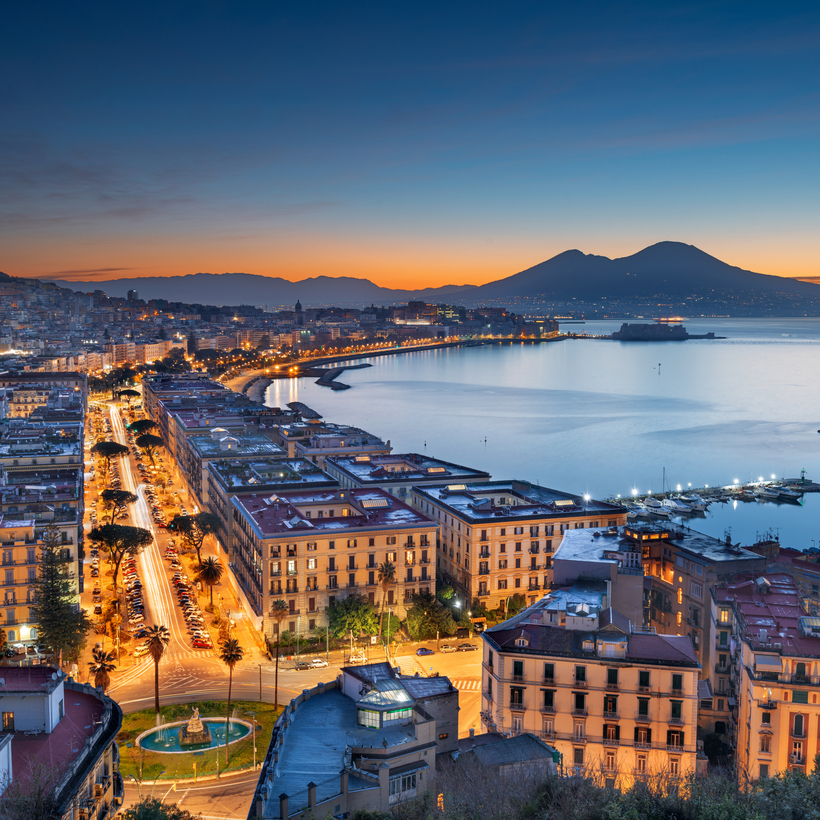The Gulf of Naples has attracted wealthy travelers since the times of ancient Rome, when Tiberius decided to live out his final decade on the island of Capri. In the 1940s and 1950s, Amalfi’s craggy coastline became a haven for artists, actors, and writers including John Steinbeck, Virginia Woolf, and Ernest Hemingway, and to say that its popularity has skyrocketed in the last half-century would be an understatement. Yet, up until recently, Naples, the coast’s largest city, was largely treated as a layover—an inconvenient train stop on the way to Amalfi, or the gateway to Capri, Ischia, and other nearby islands.
Stories of organized crime and lax police surveillance have kept travelers at bay since 1975, when the Vele di Scampia, an ambitious urban housing project in the north of the city, was completed and quickly became the de facto headquarters of a burgeoning drug trade. In 1980, the catastrophic Irpinia earthquake killed nearly 3,000 people and left 250,000 homeless, and the Camorra—the Neapolitan Mafia—pocketed $6.4 billion worth of earthquake reparations.

Mob murders and trash-disposal issues—also connected to organized crime—took over newspaper headlines and gave rise to Roberto Saviano’s book Gomorrah, which sold millions of copies around the world (and sent Saviano into hiding). By Christmas Day of 2007, nearly 45,000 pounds of garbage had clogged up the city’s streets.
Up until recently, Naples was largely treated as a layover—a train stop on the way to Amalfi, or the gateway to Capri, Ischia, and other nearby islands.
Even within Italy, Naples earned the reputation of being dirty and dangerous—Italian tourists avoided the city, and rivalry between Northern and Southern Italians increased. In soccer stadiums, Verona fans chanted racist slurs: “Smell the stink, even the dogs run away, the Neapolitans have arrived.” (To which the Neapolitans responded, “Juliet was a whore.”)
But change is finally afoot in Naples, thanks to declining crime and an influx of art galleries, restaurants, and hotels. This spring, “Picasso and Antiquity,” a show at the city’s National Archeological Museum that placed Roman sculpture alongside the Spanish painter’s work, attracted crowds and glowing reviews. The museum is planning to expand to the 18th-century Real Albergo dei Poveri.

Nearby, Gambrinus, a café opposite the Palazzo Reale, a former Bourbon royal residence, has been packed with tourists clamoring to buy $12 croissants and $5 coffees, in a city where the going rate for an espresso and cornetto hovered, until recently, at around $3. This spring, Elle published a story titled “Why Naples Is the Place to Be in 2023.” It’s like the world is taking in the city’s wonders for the first time.
And the wonders are endless. Mount Vesuvius sits majestically over the city’s uneven sprawl of buildings, a silent reminder of the tragedy of Pompeii. During the Second World War, aristocrats took shelter in their palazzi in the neighborhood of Posillipo, overlooking the sea, and some of their relatives, including Roberto Mottola Di Amato and the Caracciolo family, still have homes there.
The weather is generally dry and temperate (though, during the past few weeks, like elsewhere in Southern Europe, temperatures have soared); the men still get their suits impeccably tailored at Rubinacci (the Savile Row of Naples); and the food is some of Italy’s best, beginning, naturally, with the pizza. (A young Neapolitan chef is thought to have concocted the first pizza margherita in 1889.) The city’s welcoming spirit is embodied in the caffé sospeso, a custom of paying for an extra espresso in the name of someone who can’t afford it. In May, Naples’s victory in the Italian National Football Cup after 33 years was legendary—fireworks shot up above the sea, cars honked all night, and Maradona murals appeared across the city.

Neapolitans’ soccer fanaticism is emblematic of their personality. They talk loudly, whistle at women, and peddle worthless trinkets to tourists—but they do so irresistibly.
The city’s welcoming spirit is embodied in the caffé sospeso, a custom of paying for an extra espresso in the name of someone who can’t afford it.
“There’s something sexy about it,” a friend of mine who lives in Naples says. “In a world that revolves around Instagram, people are gravitating towards places that feel unapologetically real.”
Things began changing about five years ago. “It really started with the art world, which is driving the rest forward,” a tech entrepreneur who grew up in Naples tells me. “While Milan is about commerce, Naples is blossoming in the way of art and creativity.”
In 2018, Thomas Dane, a London-based gallerist who represents artists as diverse as Cecily Brown, Glenn Ligon, and Steve McQueen, opened an outpost on Naples’s Via Crispi. “I can’t think of another city in Europe where I would more like to see a gallery,” Dane told The Wall Street Journal at the time. “It’s a risk, but also an adventure.”

In 2022, the Milan-based Gallerie D’Italia museum followed suit. For its opening show, Caravaggio’s final masterpiece, Martyrdom of Saint Ursula, was hung in the main gallery, in the centrally located Via Toledo. Then, in January, Eva Elisa Fabbris, the director of Milan’s Fondazione Prada contemporary-art center, moved south to take the helm of the Madre Museum, where work by Sol LeWitt hangs alongside sculptures by Jeff Koons.
TV has also brought attention to the city. Elena Ferrante’s best-selling novels, which were adapted into the hit shows My Brilliant Friend and The Lying Life of Adults, have brought the Neapolitan author’s vision of the city—cacophonous and with its faults, yet irresistibly romantic—to the screen. And Italy’s most popular show this year, Netflix’s Mare Fuori, centers around a rich Milanese teenager who ends up in a juvenile correctional facility in Naples. (“We have to say thank you,” Vincenzo De Luca, the president of the city’s Campania region, told the show’s creators after the series hit No. 1 in Italy, “because you convey a beautiful image of Naples and the South—of people who fight.”)
Visitors have stayed for the food, in part thanks to Stanley Tucci’s CNN series Searching for Italy, an episode of which took place in Naples. In February, when Air Force One landed at Capodichino Airport for a technical check, Jill Biden called Enzo Coccia, a local pizzaiolo, who delivered 19 pies from his pizzeria, La Notizia, straight to the military base. (Coccia now wears a jersey emblazoned with the White House logo while making and serving his pizzas, and is planning a special recipe for the First Lady. “I’m already thinking about the ingredients,” he told the Italian national newspaper La Repubblica, “and I can already tell you that bacon will definitely be included. Americans go crazy for it.”)
“There’s something sexy about it. In a world that revolves around Instagram, people are gravitating towards places that feel unapologetically real.”
In January, the city’s oldest pizzeria, Antica Pizzeria Da Michele, dating back to 1870, opened an outpost in New York, on Bank Street in the West Village. In Naples’s Sanità neighborhood, meanwhile, chef Ciro Oliva’s restaurant, Concettina ai Tre Santi, has attracted the attention of Moncler C.E.O. Remo Ruffini, who recently acquired a 47 percent stake.

In August of 2021, the city’s formerly dangerous, suddenly hip Spanish quarter became the set for Italian Vogue’s Naples-themed issue. Models in Saint Laurent by Anthony Vaccarello posed in front of a Maradona mural in short skirts and skimpy tops. “There’s definitely a more glamorous crowd that’s curious to explore Naples now,” Emily FitzRoy, founder of the ultra-exclusive Italian agency Bellini Travel, told Elle.
The party scene is following suit. Last weekend, Discoteca, a party that usually takes place in New York and Mexico City, hosted an event in collaboration with the Neapolitan D.J. collective Soul Express, and young people flew in from all over the world for it. Local D.J.’s such as Marco Carola and Orazio Rispo (who recently dated the model Emily Ratajkowski) are also contributing to a burgeoning party scene.
To cater to the new arrivals, the Grand Hotel Parker’s, one of the city’s oldest, announced a $20 million restoration. Rocco Forte is also planning on opening a new hotel there in 2025. Billionaires, meanwhile, are up in arms over a city law that bans yachts more than 250 feet long from mooring in the main port. According to the Italian national newspaper Corriere della Sera, last month LVMH C.E.O. Bernard Arnault and IAC and Expedia chairman Barry Diller were forced to turn their boats around.
As the city grows more popular, there will inevitably be those holiday-goers who are frustrated with its arcane laws and lack of infrastructure. But those who don’t understand it perhaps never will. When I visited the city a month ago, trash bags had been re-purposed as streamers in light blue and white, the Naples soccer team’s colors, and hung up along the streets, to celebrate their recent victory. A taxi took us on a wild-goose chase around the city, picking up other customers along the way. As she made her way through the bottlenecked traffic, our driver told us stories about her friends, her family, and what she had to drink on Saturday night. As you are wont to do in Naples, we laughed all the way to the station.
Elena Clavarino is the Senior Editor at AIR MAIL


